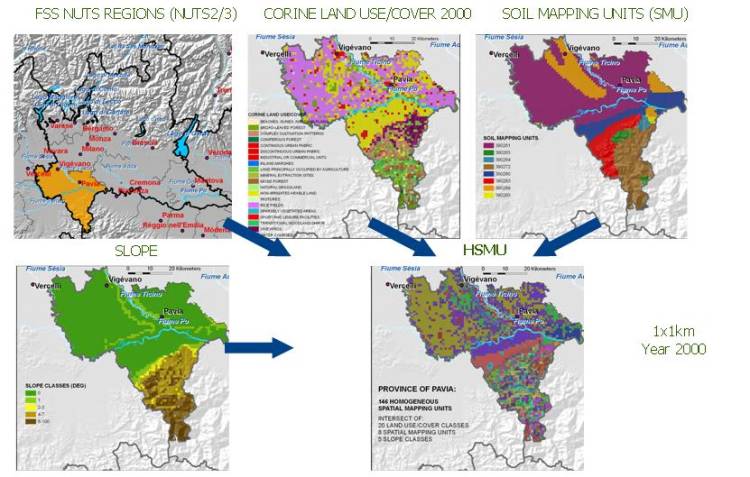Agricultural land use and environmental indicators at 1x1 km grid resolution- the concept of Homogenous Soil Mapping Units
The HSMU or Homogenous Spatial Mapping Units are the georeferenced units for which the different data and indicators of the spatial data set are defined. They define areas inside administrative regions where approxiamte homogeniety according to location factors driving farm mamangement decisions may be assumed as the units are delineated from the following features,
- CORINE land cover, which define regional land cover units
- Administrative borders (NUTS 3), limiting the otherwise discontinuous HSMU in space
- Soil Mapping Units from the Europe Soil Map
- Slope class derived from the digital elevation model
Each HSMU consists of one or several 1×1 km grid cell, not necessarily adjacent. Small HSMU comprising one one or a few 1×1 km cells are found where land cover or bio-physical conditions show a huge spatial variation, whereas very large HSMU are found in some cases where land cover, soil and slope are uniform over a bigger areas, e.g. in the northern part of Finland and Sweden, increasing the efficiency and accuracy in using indicator calculators and bio-physical models.
All features had been first converted to a uniform 1×1 km grid, and where applicable, area weighted average defined. In additional to the delination features, the following parameters had been added to the data set to be used in the statistical estimators and the bio-physical model DNDC:
- Different soil parameter (clay and sand content, soil organic carbon content, ph, packing density
- Long term climatic averages (monthly max and min temperature, solar radiation, rainfall)
- Altitude
More information
Kempen M., Heckelei T. and Britz W.:
A Statistical Approach for Spatial Disaggregation of Crop Production in the EU, in: Arfini F. (editor): Modelling Agricultural Policies: State of the Art and New Challenges, Proceedings of the 89th European Seminar of the European Association of Agricultural Economists (EAAE), Parma, Italy, Februrary 3-5, 2005 (pages 810-830)
Leip, A., Marchi, G., Koeble, R., Kempen, Britz W. and Li, C.:
Linking an economic model for European agriculture with a mechanistic model to estimate nitrogen losses from cropland soil in Europe
Biogeosciences, 5(1): 73-94
Last Updated:Tuesday, October 28, 2008
